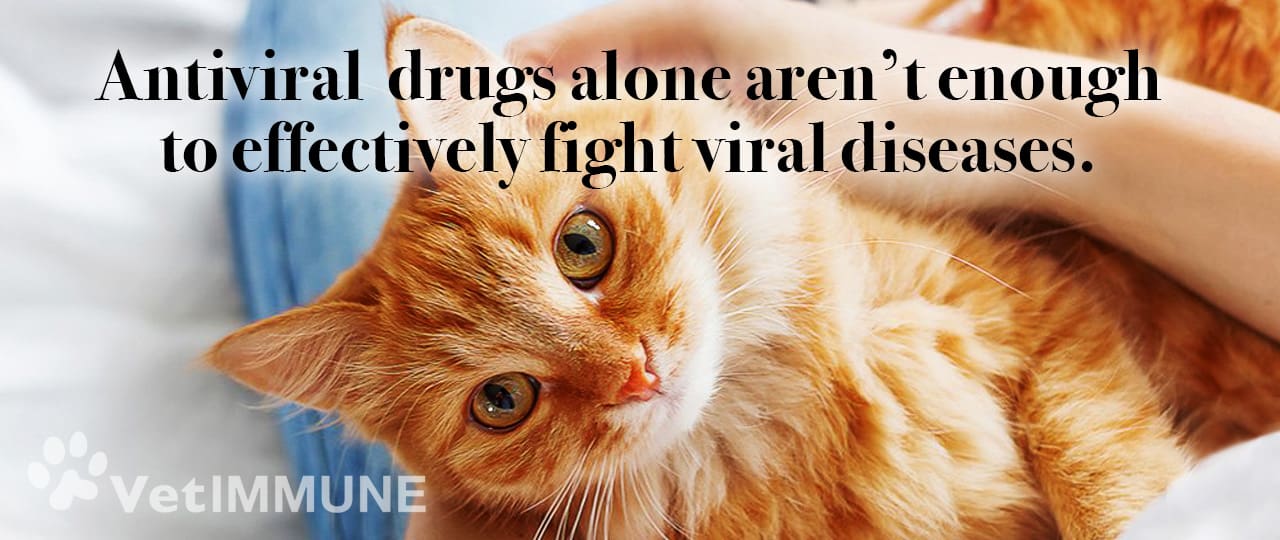
There are three approaches to address/treat/control viral diseases, including in cats:
1 – Vaccination
2 – Direct antiviral drugs
3 – Immunomodulatory drugs
Over the past century, veterinary medicine has developed antiviral drugs and vaccines to treat, try to treat, or prevent feline viral diseases.
Vaccines are highly specific, large molecules that bind and neutralize a particular virus they recognize. The effectiveness of vaccines varies. If vaccine developers miss the viral identity, the vaccine is ineffective to protect the organism from it – that’s what, for example, happens with the flu. The problem with creating FIP vaccines, for example, is likely due to the fact that Feline Infection Peritonitis Virus (FIPV) has a very wide variety of “identities” with two major serotypes, multiple strains, and individual variability.
Viral diseases develop when a virus is using the cat’s cells to replicate. The organism protects itself with a system of defenses known as immunity. Because immunity is a barrier for viruses, those evolve in various ways to avoid or eliminate barriers and reduce resistance. Some viruses mimic the host organism’s molecules and get into the cells by evading the immune system. Once inside the immune cells, viruses replicate using the cells and then kill them from within. Other types of viruses defeat immunity by building their own functional molecules and assembling viral particles inside non-immune cells. Because immunity is what protects the cat(s), it is the first target of viruses: one way or another, the invader needs to break through the defenses.
A course of an antiviral drug may affect the current, ongoing viral activity, but it does not prevent the infection from reoccurring later.
2 – VIRAL DISEASES AND DIRECT ANTIVIRAL DRUGS
Antiviral drugs interfere with the entry of the virus into the cell, or replication of viruses, by trying to prevent biosynthesis of viral nucleic acids or proteins, or their assembly into new viral particles. Over the past century, direct antiviral drugs have helped with various feline viral diseases; yet, they often prove insufficient with severe viral diseases and even ineffective with some others.
There’s a reason for that: with most viral infections, antiviral drugs are used to suppress viral replication. However, the majority of viruses cannot be killed or cleared completely, and some of them remain in the organism at any point in time. A course of an antiviral drug may affect the current, ongoing viral activity, but it does not prevent the infection from reoccurring later. Direct antiviral drugs fail to prevent relapses or treat immune-related diseases because they do not address the real reasons why cats develop certain viral diseases: the suppression of immunity. These occur due to the cat’s inherited genetic, living environment, and stress-inducing situations for cats, such as major changes in the fur-child family, or crowded living space such as shelters, catteries, and multiple-cat households.
This is the main reason why antiviral drugs (when available) often prove insufficient or even ineffective with immunity related veterinary viral diseases such as, for example, Feline Viral Rhinotraheitis (FVR) and related FHV-1 and URI, Feline Leukemia, Feline Immunodeficiency, and Feline Infectious Peritonitis (FIP).
Consequently, a cure for FVR, Feline Leukemia, FIP, and several other viral diseases is not feasible. It is why veterinarian researchers and practitioners are now trying to develop effective treatments that will address and compensate for the true reasons why cats develop such viral diseases in the first place: genetic immunodeficiency and the suppression of immunity.
And because viruses use a host’s cellular machinery to replicate, antiviral drugs that need to be tailored to specific viruses interfere with basic processes in the body’s own cells. This is what causes adverse reactions (i.e., side-effects). Fine-tuning the dose of an antiviral to each cat is an impossible task. So dosage for clinical practice is based on the lowest probability of side effects – which may happen, regardless.
Direct antiviral drugs are designed, by definition, to try to kill viruses and/or reduce viral load, which is only an “effect” of a disease but not a real “cause.” However, an antiviral drug by design is not able to treat a real reason why the disease manifests itself – the immune deficiency.
That is why there are still many feline viral diseases for which effective direct antiviral drugs have not or cannot be made or used. Even if a reasonably effective and safe antiviral drug becomes available, what about the cat’s immunity, which was suppressed or damaged by the virus? Neglecting to rebuild the cat’s immune system means you leave the damage and the ruins. The cat still feels sick and remains susceptible to relapses, other diseases, and viral re-infection. You may have taken care of one aspect of the illness: the ongoing viral replication. Still, you have failed to address the root of the issue: the failure of the immune system that, for one reason or another, allowed the viral infection to develop in the first place.
Direct antiviral drugs fail to prevent relapses in immune-related diseases because they do not address the real reasons why cats develop viral diseases: immunodeficiency and the suppression of immunity.
This brings us to the essential yet sometimes overlooked part of any effective, long-term solution to viral diseases: how to prevent the destruction or restore/reprogram the cat’s immunity damaged by the viruses.
